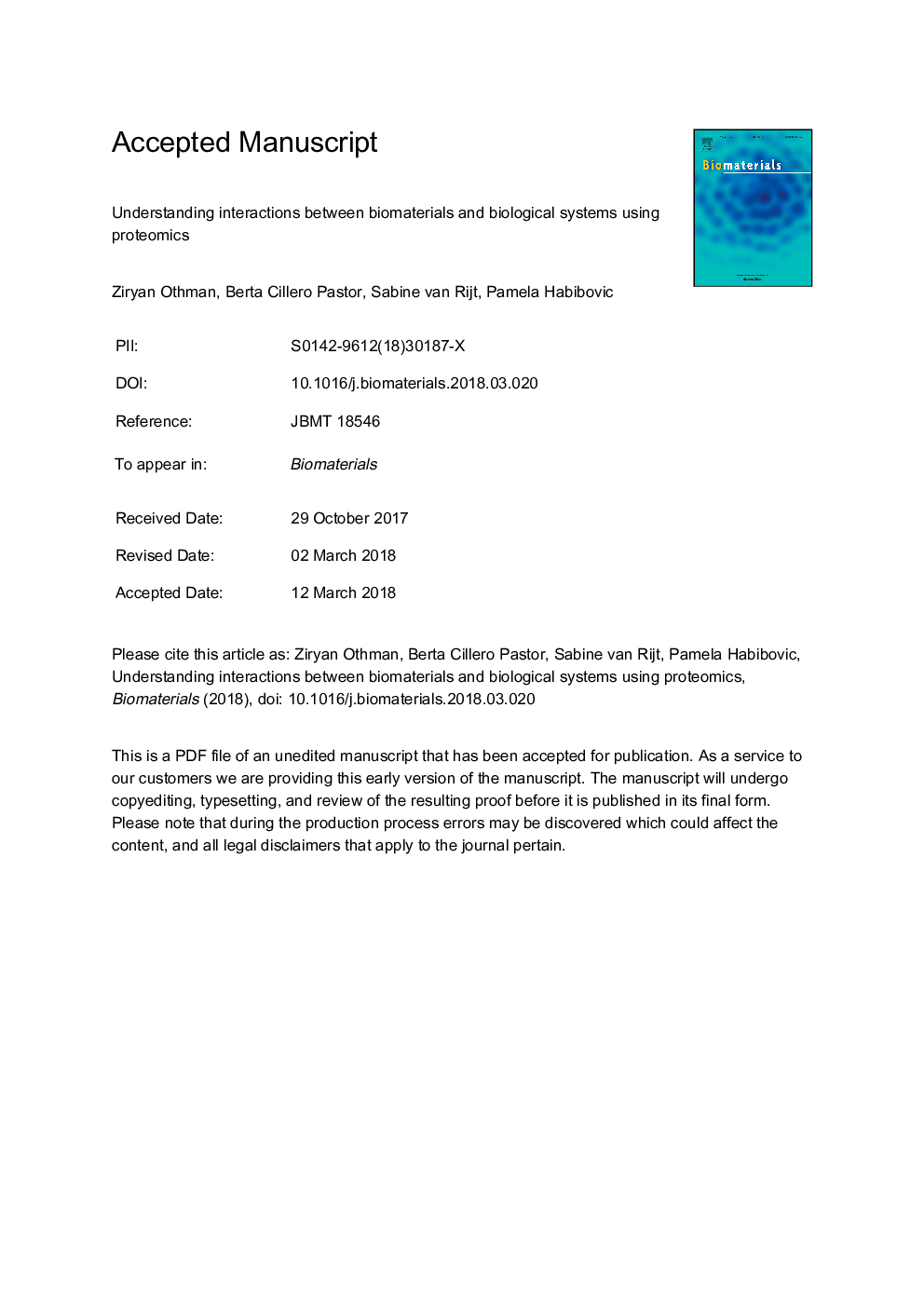| کد مقاله | کد نشریه | سال انتشار | مقاله انگلیسی | نسخه تمام متن |
|---|---|---|---|---|
| 6484544 | 1416100 | 2018 | 34 صفحه PDF | دانلود رایگان |
عنوان انگلیسی مقاله ISI
Understanding interactions between biomaterials and biological systems using proteomics
ترجمه فارسی عنوان
درک تعاملات بین مواد زیستی و سیستم های بیولوژیکی با استفاده از پروتئومیک
دانلود مقاله + سفارش ترجمه
دانلود مقاله ISI انگلیسی
رایگان برای ایرانیان
کلمات کلیدی
بیومارکرهای، داروهای احیا کننده، پروتئین ها، نمایش محتویات بالا، طیف سنجی جرمی،
ترجمه چکیده
نقش بیومارایتی ها در درمان بالینی اندام ها و بافت های آسیب دیده تغییر می کند. در حالیکه مواد بیولوژیکی که در دستگاه های دائمی پزشکی استفاده می شوند، به طور غیرمستقیم باید در طول مدت کار بافت بافت آسیب پذیر را بر عهده بگیرند، انتظار می رود که مواد زیستی فعلی باعث ایجاد و پتانسیل خود بازسازی بدن در محل شود و سپس از بین بردن آن، پزشکی احیا کننده. برای پاسخگویی به این نیازهای مختلف، ضروری است که به طور کامل درک متابولیسم های بیولوژیکی با سیستم های بیولوژیکی، در فضا و در زمان. این دانش منجر به درک بهتر از توانایی های بازسازی مواد بیولوژیکی که در طراحی آنها با قابلیت های بهبود یافته (مثلا سازگاری بیولوژیکی، بیولوژیک) کمک می کند. پروتئین ها نقش مهمی در تعامل بین مواد بیولوژیکی و سلول ها یا بافت ها ایفا می کنند. جذب پروتئین بر روی سطح مواد اولین مرحله از این تعامل است، که تعیین کننده برای فرآیندهای پس از رشد سلولی، تمایز و تشکیل ماتریس خارج سلولی است. در مقابل این زمینه، هدف بررسی حاضر این است که بینش در دانش فعلی از نقش پروتئین در تعاملات سلولی بیومتریکی و بافت-بیومتریکی برقرار شود. به طور خاص، تمرکز بر روی مطالعات پروتئومیک، عمدتا با استفاده از طیف سنجی جرمی و دانش آنها در جذب پروتئین مواد بیولوژیکی، تولید پروتئین توسط سلول های کشت شده بر روی مواد، ایمنی و کارایی مواد جدید بر اساس نانوذرات و تجزیه و تحلیل ماتریکس های خارج سلولی و محصولات حاصل از ماتریکس خارج سلولی. در چشم انداز، پتانسیل و محدودیت های این روش مورد بحث قرار گرفته است و تصویربرداری جرم طیف سنجی به عنوان یک تکنیک قدرتمند ارائه می شود که مکمل های تکنولوژیکی طیف سنجی جرمی را با فراهم آوردن اطلاعات مکانی مولکولی در مورد تعاملات سیستم های مواد-بیولوژیک ارائه می دهد.
موضوعات مرتبط
مهندسی و علوم پایه
مهندسی شیمی
بیو مهندسی (مهندسی زیستی)
چکیده انگلیسی
The role that biomaterials play in the clinical treatment of damaged organs and tissues is changing. While biomaterials used in permanent medical devices were required to passively take over the function of a damaged tissue in the long term, current biomaterials are expected to trigger and harness the self-regenerative potential of the body in situ and then to degrade, the foundation of regenerative medicine. To meet these different requirements, it is imperative to fully understand the interactions biomaterials have with biological systems, in space and in time. This knowledge will lead to a better understanding of the regenerative capabilities of biomaterials aiding their design with improved functionalities (e.g. biocompatibility, bioactivity). Proteins play a pivotal role in the interaction between biomaterials and cells or tissues. Protein adsorption on the material surface is the very first event of this interaction, which is determinant for the subsequent processes of cell growth, differentiation, and extracellular matrix formation. Against this background, the aim of the current review is to provide insight in the current knowledge of the role of proteins in cell-biomaterial and tissue-biomaterial interactions. In particular, the focus is on proteomics studies, mainly using mass spectrometry, and the knowledge they have generated on protein adsorption of biomaterials, protein production by cells cultured on materials, safety and efficacy of new materials based on nanoparticles and the analysis of extracellular matrices and extracellular matrix-derived products. In the outlook, the potential and limitations of this approach are discussed and mass spectrometry imaging is presented as a powerful technique that complements existing mass spectrometry techniques by providing spatial molecular information about the material-biological system interactions.
ناشر
Database: Elsevier - ScienceDirect (ساینس دایرکت)
Journal: Biomaterials - Volume 167, June 2018, Pages 191-204
Journal: Biomaterials - Volume 167, June 2018, Pages 191-204
نویسندگان
Ziryan Othman, Berta Cillero Pastor, Sabine van Rijt, Pamela Habibovic,
